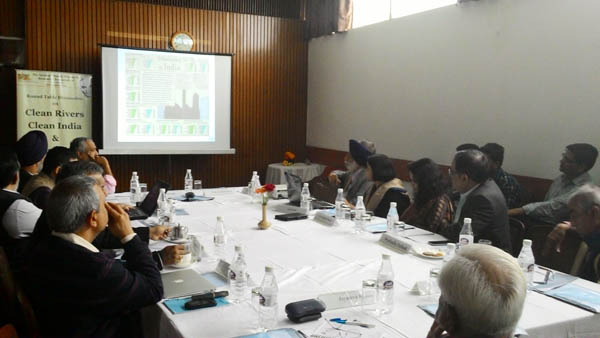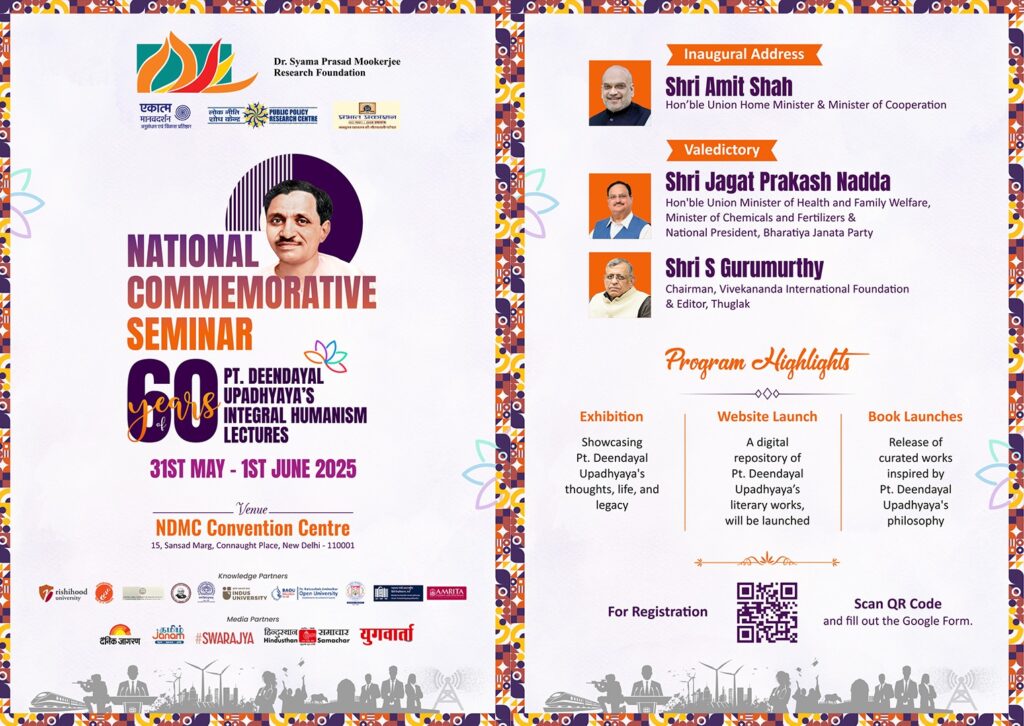A Report :
Dr. Syama Prasad Mookerjee Research Foundation, New Delhi organized a Round Table discussion on ‘Clean Rivers, Clean India & Smart Cities’ on March 3rd, 2015 at the India International Centre, New Delhi. The Round Table saw the participation of eminent panelists which included industry leaders, domain experts, fellows from leading think tanks, retired senior bureaucrats, etc. There was also a presentation by a team of visiting experts from the Centre for Ecology & Hydrology, United Kingdom, who were members of the team responsible for the cleanup of the river Thames.
The Round Table started with an introduction to the topic given by Dr. Anirban Ganguly, Director, Dr. Syama Prasad Mookerjee Research Foundation, New Delhi which was then discussed further by Shri Raj Liberhan, former Director, India Habitat Centre and a well-known Urban Designer who said, “when it comes to the issues of cleanliness and sanitation, cities demand to 50-55% of our attention and hence it is important that we shift our focus on creating smart cities”. Following are some salient points that came up during the discussion.
Eminent architect Prof. K.T. Ravindran said that the first step towards creating smart cities is addressing the problems of packaging industry which uses non-biodegradable waste. He said that the major pollutants these days are e-waste, hospital waste and toxic waste (including nuclear waste). He said, “despite dumping waste outside the cities, we have less and less land for dumping. The solution to it lies in proper processing of waste.” Prof. Ravindran emphasized the need to treat both the visible waste (including human waste) and invisible (toxic waste going into water resources)” and pointed out that according to a research the level of arsenic in the soil and water of Varanasi is 20 times more than the tolerance level. Prof. Ravindran emphasized the need to undertake serious time-bound research on the various dimensions of this issue. The data and research thus generated should be disseminated to cover the information gap in the research for smart cities. He also argued that the idea of ‘Swachhata’ should percolate down to the people in general and become a mission.
Ms. Mriganka Saxena, Partner, Habitat Tectonics Architecture & Urbanism, highlighted the problem that India is currently facing and would be facing in future owing to unplanned urbanization. Today the number of urban dwellers is 377 million which is likely to increase to a whooping 900 million by 2050. She said, “the major problems that India is facing and would be facing because of unplanned urbanization are mobility problem, housing crisis, congestion in living space and waste production among other things.” She said that when we talk about environment it includes quality of life and the quality of life depends on choices that are available to you. She further said that we need to make mini city development programmes (CDPs) before going smart.
Ms. Ankhi Das, Director, Public Policy, Facebook India, said that there is an urgent need to address the problems faced by telecom companies and internet service providers (ISPs) in the field of infrastructure development to address the need of uninterrupted connectivity which are an essential feature of smart cities. She emphasized a need for a national regulation for single window clearance system to address the problems of infrastructure block faced by telecom companies and ISPs.
Shri Pradeep Puri, Chairman FICCI, Urban Infrastructure Committee & CEO ILFS Group stressed on the urgent need to address two main problems faced by urban populace one, the need for safe and uninterrupted drinking water supply. Second, the need proper system for treating the waste.” Shri Puri also pointed out that there was an urgent need to strengthen local elected bodies to solve problems of sanitation, infrastructure, water, etc.”
Dr. Kulwant Singh, Regional Advisor, UN Habitat, highlighted the failure of JNNURM where the governments could not even use half of the allocated money. He said that it was only because of lack of proper planning. Dr. Singh argued that there should be a sense of ownership among the administrative bodies, elected bodies and the local communities towards their cities/towns.
Shri Sanjay Gupta, an independent expert of water resources said, that there should be a focus on prevention rather than curing the problem. We must start using technology for a sustainable living. Since sanitation is directly linked to health we must first make sure pollutants don’t flow into river and drinking water rather than cleaning the polluted water later on.”
Shri Jayadeva Ranade. Former Addl. Secretary, GoI said that there is an urgent need to address the problem of dwindling food production and water crisis, and to address these problems we must fix accountability by monetary mechanisms.
Dr. Uttam K. Sinha, Fellow, IDSA spoke on the need for “smart cities to be safe cities in terms of preventing risks of sanitation, infrastructure, and suggested that communities and religious circles need to be engaged for spreading the message of cleanliness
Shri Shakti Sinha, Retd. IAS, emphasized the need to increase green cover by pushing the density of population upward and downward. He said, “if you don’t have provision for cycles and walking, you can’t have smart cities.”
A team from the UK based Centre for Ecology & Hydrology (CEH) gave a detailed presentation on cleaning of the river Thames. The team comprised of Dr. Gwyn Rees, Director CEH, Dr. Martin Griffiths, former Head of Water Quality for the UK Environment Agency & Deputy Director of Regulation, Department of Environment, Food & Rural Affairs and Mr. Ben Piper hydrologist and water resource planner.
Dr. Martin Griffins led the presentation and said there are three dimensions of the Thames river cleanup project. They are (a) Governance, (b) Research, (c) Infrastructure. He further said that since India has shown political will for cleaning the river Ganga, it needs proper research and infrastructure to give shape to the project. The delegation also laid down the need for a “Competent Authority” for conservation and protection of water environment. They said that the environment agency (ministry) in the UK is the competent authority for protection of water environment. All in all the presentation gave a vivid description of the evolution of the efforts to the clean the Thames from the 1860s when it was a near dead river to the present day when it has achieved a high degree of cleanliness.
The Round Table ended with a discussion moderated by Shri Raj Liberhan and a vote of thanks proposed by Dr. Anirban Ganguly to the panelists and experts.
(The views expressed are the author's own and do not necessarily reflect the position of the organisation)


